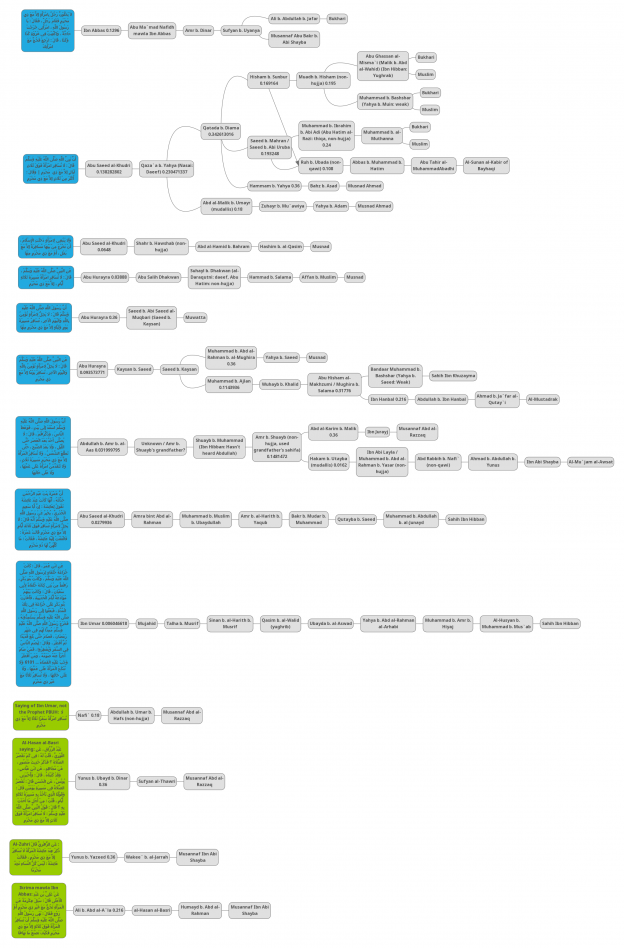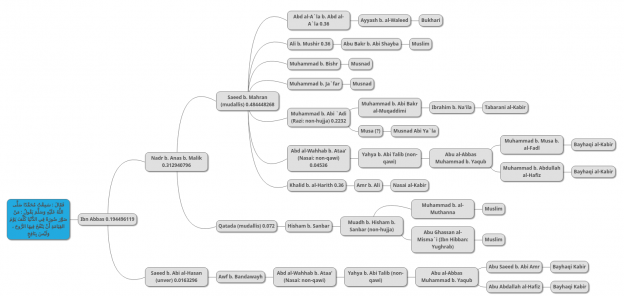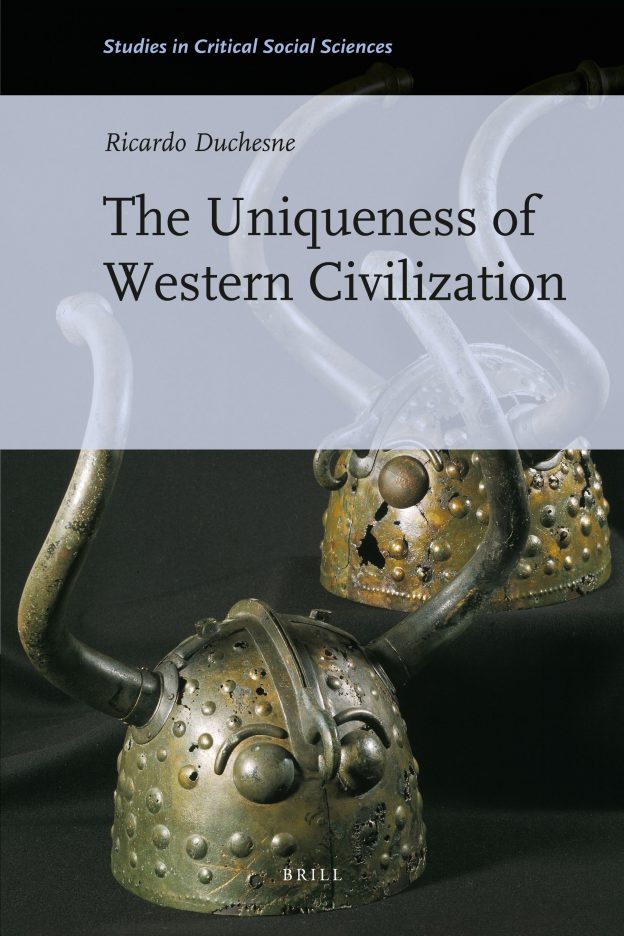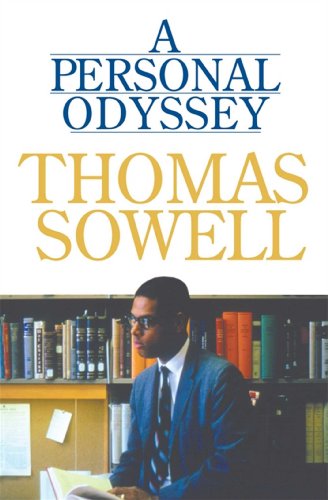My new book: Learning Modern Standard Arabic for Complete Beginners
In August last year I thought I could start working again, but I was wrong. In March this year things changed and I was able to start working on my book Learning Standard Arabic (MSA) for Complete Beginners, a book I have wanted to write since 2019. It is based on the same learning method as my other book, Learning Quranic Arabic for Complete Beginners.
In over 350 pages, readers begin by learning the alphabet and go on read a fable from Aesop, a story about a boy’s trip through Jerusalem with his grandfather, then move on to modern Arabic poetry. Meanwhile proper transliterations and pronunciation are provided for every single sentence of Arabic, using my beloved Brill Encyclopedia of Islam system.
Buy it on Amazon (US): Kindle | Paperback
UK: Kindle | Paperback
From then on I take readers through what is perhaps the greatest Arabic poem written in the past century or two, the 119-line Rain Song by the Iraqi poet Badr Shaker al-Sayyab.(1926-1964). This poem is the only piece of Arabic writing I have read that is almost as hard-hitting as the Quran, making shivers run through your skin.
In the fourth part learners read a poem by the Persian intellectual Ali Shariati (1933-1977) called One and Beside it Zeroes Without End. There was no proper Arabic translation of it, so I had to translate it from Persian to Arabic, and of course from Arabic to English. It is written in the form of a Persian fable with a strong spiritual meaning it, starting from God creating the world.
It is strange but what I have discovered (I could be wrong, though) is that when I stop trying to work toward big goals and missions, when I simply tell myself that my job is simply to live, to be, with no greater goal in life, that is when I can actually work on the things I love. It is like a dark cloud is removed and my energy and inspiration comes back.
I have written an article about this, and once I’m reasonably sure I’m not mistaken I will publish it. I may be able to come back to my regular work in Islamic studies, but I do not know.
On Using HadithGraph
Link to the tool: HadithGraph
I have been quietly working on a tool that automatically diagrams and “verifies” hadiths (based on my hadith verification method), and recently I finished it, and the results far exceeded my expectations, alhamdulillah. The tool is simply a calculator and diagrammer, so that instead of having to do the probability calculations and diagramming manually, they all take place automatically.
Users can use the tool merely for diagramming hadith chains, even if they have no interest in the probability calculations.
See the essay linked above for how the probability calculation works.
Rewriting and inputting the chains
Given the Bukhari hadith (Bukhari #1):
حَدَّثَنَا الحُمَيْدِيُّ عَبْدُ اللَّهِ بْنُ الزُّبَيْرِ ، قَالَ : حَدَّثَنَا سُفْيَانُ ، قَالَ : حَدَّثَنَا يَحْيَى بْنُ سَعِيدٍ الأَنْصَارِيُّ ، قَالَ : أَخْبَرَنِي مُحَمَّدُ بْنُ إِبْرَاهِيمَ التَّيْمِيُّ ، أَنَّهُ سَمِعَ عَلْقَمَةَ بْنَ وَقَّاصٍ اللَّيْثِيَّ ، يَقُولُ : سَمِعْتُ عُمَرَ بْنَ الخَطَّابِ رَضِيَ اللَّهُ عَنْهُ عَلَى المِنْبَرِ قَالَ : سَمِعْتُ رَسُولَ اللَّهِ صَلَّى اللَّهُ عَلَيْهِ وَسَلَّمَ يَقُولُ : إِنَّمَا الأَعْمَالُ بِالنِّيَّاتِ ، وَإِنَّمَا لِكُلِّ امْرِئٍ مَا نَوَى ، فَمَنْ كَانَتْ هِجْرَتُهُ إِلَى دُنْيَا يُصِيبُهَا ، أَوْ إِلَى امْرَأَةٍ يَنْكِحُهَا ، فَهِجْرَتُهُ إِلَى مَا هَاجَرَ إِلَيْهِ *
Enter the hadith’s isnad in the textbox as follows:
Umar b. al-Khattab > Alqama b. al-Waqqas > Muhammad b. Ibrahim > Yahya b. Saeed > Sufyan > al-Humaydi
The chain starts from the chief transmitter (the Companion, in this case Umar. b. al-Khattab [RA]), and the transmitter names are separated by ” > “. Note that there are spaces before and after the “>”.
The spelling of the names does not matter as long as it is consistent. You must always use the same exact spelling for each unique transmitter, so Umar b. al-Khattab must always be spelled “Umar b. al-Khattab” in any additional chains you add.
But there is no need to worry too much about getting spellings wrong, because the diagram will immediately make it obvious by making the transmitter show up twice (below we have erroneously spelled Umar b. al-Khattab’s name differently on different chains):
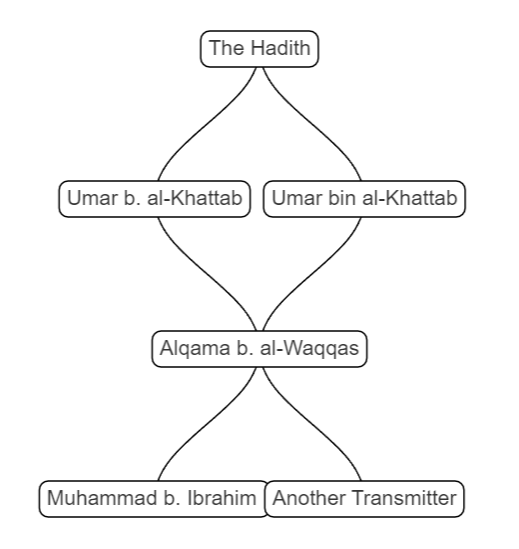
Then gather additional chains for this hadith using hadith search engines and/or takhrīj tools, for example Bukhari #6587 gives us another chain for the hadith:
6587 حَدَّثَنَا أَبُو النُّعْمَانِ ، حَدَّثَنَا حَمَّادُ بْنُ زَيْدٍ ، عَنْ يَحْيَى بْنِ سَعِيدٍ ، عَنْ مُحَمَّدِ بْنِ إِبْرَاهِيمَ ، عَنْ عَلْقَمَةَ بْنِ وَقَّاصٍ ، قَالَ : سَمِعْتُ عُمَرَ بْنَ الخَطَّابِ رَضِيَ اللَّهُ عَنْهُ ، يَخْطُبُ قَالَ : سَمِعْتُ النَّبِيَّ صَلَّى اللَّهُ عَلَيْهِ وَسَلَّمَ يَقُولُ : يَا أَيُّهَا النَّاسُ ، إِنَّمَا الأَعْمَالُ بِالنِّيَّةِ ، وَإِنَّمَا لِامْرِئٍ مَا نَوَى ، فَمَنْ كَانَتْ هِجْرَتُهُ إِلَى اللَّهِ وَرَسُولِهِ ، فَهِجْرَتُهُ إِلَى اللَّهِ وَرَسُولِهِ ، وَمَنْ هَاجَرَ إِلَى دُنْيَا يُصِيبُهَا أَوِ امْرَأَةٍ يَتَزَوَّجُهَا ، فَهِجْرَتُهُ إِلَى مَا هَاجَرَ إِلَيْهِ *
Now enter the new chain from this second hadith into a new line in the textbox, so that we have the following two lines:
Umar b. al-Khattab > Alqama b. al-Waqqas > Muhammad b. Ibrahim > Yahya b. Saeed > Sufyan > al-Humaydi
Umar b. al-Khattab > Alqama b. al-Waqqas > Muhammad b. Ibrahim > Yahya b. Saeed > Hammad b. Zayd > Abu al-Nu`man
Now we get the following diagram:
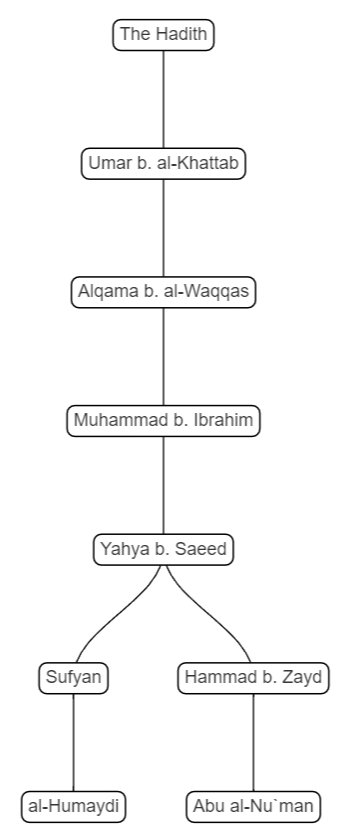
And below we have added a chain from a third hadith (Bukhari 3719):
Umar b. al-Khattab > Alqama b. al-Waqqas > Muhammad b. Ibrahim > Yahya b. Saeed > Sufyan > al-Humaydi
Umar b. al-Khattab > Alqama b. al-Waqqas > Muhammad b. Ibrahim > Yahya b. Saeed > Hammad b. Zayd > Abu al-Nu`man
Umar b. al-Khattab > Alqama b. al-Waqqas > Muhammad b. Ibrahim > Yahya b. Saeed > Hammad b. Zayd > Musaddad
Adding hadith collection information
If you wish the details of the hadith collection to show up on the diagram, you may add it as follows:
A > [Bukhari]
B > [Muslim]
That is, the hadith collection information must be enclosed in square brackets. Adding the hadith collection information to the diagram has no effect on the probability calculations.
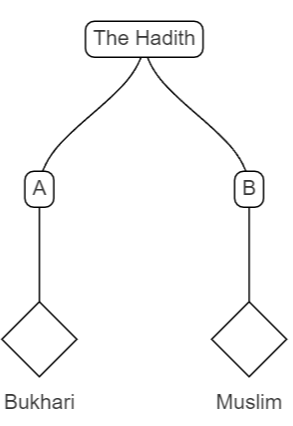
Important: Using square brackets here is essential, otherwise the hadith collection will be treated like any other transmitter, causing inaccurate calculations.
Adding comments
Comments can be added for your own convenience; they have no effect on the diagram or probability calculation. Comments start with a “#” character. You can add comments before each chain as follows:
# Bukhari 1
Umar b. al-Khattab > Alqama b. al-Waqqas > Muhammad b. Ibrahim > Yahya b. Saeed > Sufyan > al-Humaydi
# Bukhari 6587
Umar b. al-Khattab > Alqama b. al-Waqqas > Muhammad b. Ibrahim > Yahya b. Saeed > Hammad b. Zayd > Abu al-Nu`man
# Bukhari 3719
Umar b. al-Khattab > Alqama b. al-Waqqas > Muhammad b. Ibrahim > Yahya b. Saeed > Hammad b. Zayd > Musaddad
Setting custom probabilities
Each transmitter has a default probability 0.6 (i.e. 60%). Sometimes you are dealing with transmitters who are lower quality, although not totally unreliable. In those cases you can set a custom probability in brackets after the transmitter’s name, as follows:
Transmitter 1 > Transmitter 2 (0.4) > Transmitter 3
Above, Transmitter 2 gets a probability of 0.4 (40%) in the calculations.
Setting probabilities above 0.6 will be ignored.
We are verifying meanings
This tool gives the probable authenticity of the text (matn) of the hadith. But some variant hadiths sometimes contain additional sentences or lack them. Make sure all of the chains are the chains of hadith texts that mention the meaning you are trying to verify, such as “all actions are judged (by God) by the intentions behind them”.
Just an update
The last time I did any serious work in Islamic studies was four years ago, in March-April 2019, when I was busy showing that, according to my hadith verification method, none of the pro-predestination hadiths were reliable. I was never able to finish that work.
I might possibly be “back” and I might be able to continue the kind of work I was busy with in 2017-19. But I cannot promise anything; only God knows what is in store for me.
I apologize to all the people I’ve failed to respond to. My condition worsened in 2019, and in 2020 due to Covid-19 I ended up being sick and fatigued for months at a time. Sometimes for months at time even reading a paragraph of text was more than I could do. In early 2021 I had a minor stroke during the fourth or fifth time that I had Covid-19, and I’m still recovering from that.
But I’ve still been able to do a lot of reading over the past four years in order to cure my lamentable ignorance about many things. A lot of my reading is in academic monographs and essay collections, so perhaps it’s not all entirely useless entertainment for myself. I’ve read 252 books since April 2019, if we count Quran re-readings too. Here are some of the books I’ve read in 2023 so far:
- Ian Hodder, Studies in Human-Thing Entanglement (2016)
- C. S. Lewis, The Discarded Image: An Introduction to Medieval and Renaissance Literature (1964)
- Owen Barfield, History in English Words (1967 Eerdmans [1953])
- Neil Rhodes, Shakespeare and the Origins of English (2004)
- Ahmad al-Jallad, The Religion and Rituals of the Nomads of Pre-Islamic Arabia: A Reconstruction Based on the Safaitic Inscriptions (2022)
- Peter Magee, The Archaeology of Prehistoric Arabia: Adaptation and Social Formation from the Neolithic to the Iron Age (2014)
- Robert G. Hoyland, Arabia and the Arabs: From the Bronze Age to the Coming of Islam (2001)
- Norman Yoffee, Myths of the Archaic State: Evolution of the Earliest Cities, States and Civilizations (2004)
- Kay Redfield Jamison, Touched With Fire: Manic-Depressive Illness and the Artistic Temperament (1993)
- Leslie A. Marchand, Byron: A Portrait (1976 [1971])
- Second reading of C. S. Lewis’s Space Trilogy: Out of the Silent Planet (1938), Perelandra (1943), and That Hideous Strength (1945).
- C. S. Lewis, Till We Have Faces (1956) (second reading)
- C. S. Lewis, The Great Divorce (1945) (second reading)
- C. S. Lewis, The Pilgrim’s Regress (1933) (second reading)
- James Turner, Philology: The Forgotten Origins of the Modern Humanities (2014)
- John W. Chaffee, The Thorny Gates of Learning in Sung China: A Social History of Examinations (1985?)
- Johannes Pedersen, The Arabic Book (1984 [1946]) tr. Geoffrey French ed. Robert Hillenbrand
- Jim B. Tucker, Return to Life: Extraordinary Cases of Children Who Remember Past Lives (2013)
- Ian Stevenson, European Cases of the Reincarnation Type (2003)
- Ian Stevenson, Children Who Remember Previous Lives: A Question of Reincarnation (Revised Edition) (2001/1987)
- Ian Stevenson, Where Reincarnation and Biology Intersect (1997)
- James G. Matlock, Signs of Reincarnation: Exploring Beliefs, Cases, and Theory (2019)
- Bruce Greyson, After: A Doctor Explores What Near-Death Experiences Reveal About Life and Beyond (2021)
- Titus Rivas, Anny Dirven, and Rudolf H. Smit, The Self Does Not Die: Verified Paranormal Phenomena from Near-Death Experiences (2016)
- Jeffrey Long and Paul Perry, God and the Afterlife: The Groundbreaking New Evidence for God and Near-Death Experience (2016)
- Kenneth Ring, Lessons from the Light: What We Can Learn from the Near-Death Experience (1998, 2006)
- Raymond A. Moody, Life After Life (25th Anniversary Edition) (1975, 2001)
Among these the most eye-opening one was al-Jallad’s The Religion and Rituals of the Nomads of Pre-Islamic Arabia. There’s something strange and wonderful about seeing inscriptions by pre-Islamic Arabians writing things in a very strange alphabet that, once deciphered, is very recognizably “Arabic”.
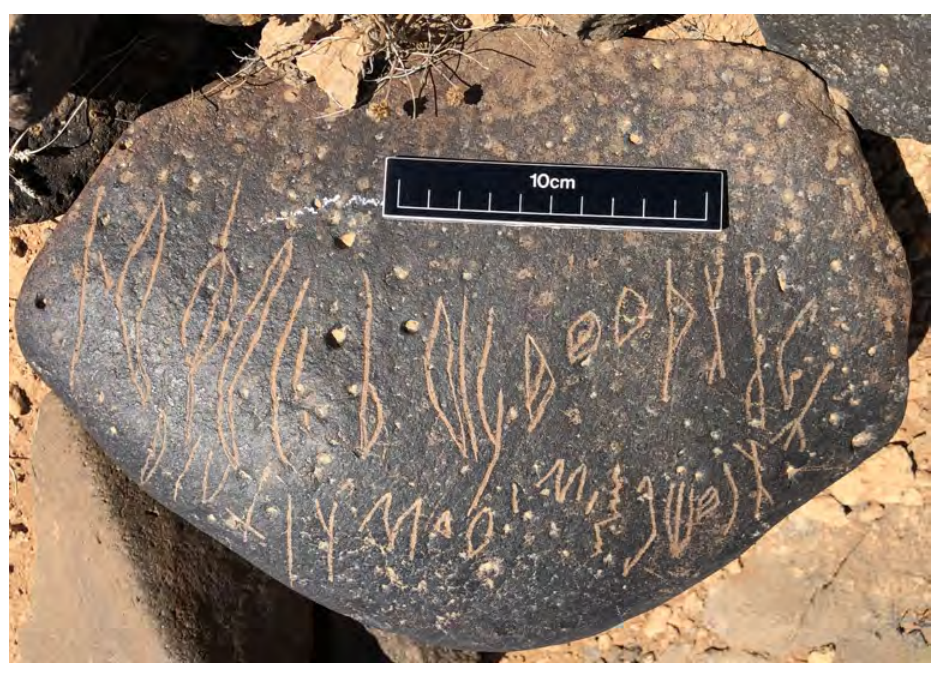
l mqm bn ymlk w wgd ʾṯr ḏʾb w ḥrśn f ngʿ f h lt slm
‘By Mqm son of Ymlk and he found the traces of Ḏʾb and Ḥrśn and grieved in pain
so, O Allāt, may he be secure.’
The transliteration above does not add vowels because it is not known how the people who made these inscriptions actually pronounced these words. Reconstructing the pronunciation from Arabic would be premature and unscholarly. But regardless of the pronunciation, turning these letters into Arabic makes most of the words make some kind of sense in Arabic:
wgd ʾṯr = وَجَدَ أَثَرَ = "he found the traces of"
f h lt slm = فها الّات سَلِّم = O Allāt [the name of the pagan goddess] make safe / provide safety
C. S. Lewis
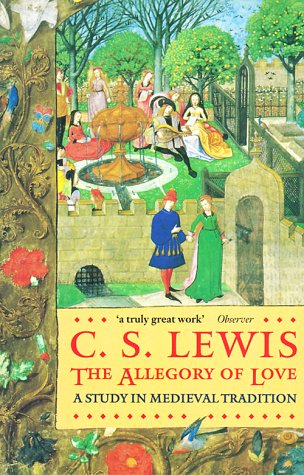
In August 2019 I read C. S. Lewis’s Allegory of Love (an academic book on medieval poetry), and I soon sensed that he was truly “a man after my own heart”. I went on to read over 30 other books by him, including his 4000-page collected letters. When I discover one of those extremely rare thinkers who show promise that they can teach me something new, I tend to read all of their books that I can get my hands on. There’s still an important book of his I haven’t read, the 600+ page Poetry and Prose in the Sixteenth Century.
Tolstoy
In early 2021 I read Tolstoy’s War and Peace and saw that he was another one of the greats worth reading. Since then I have read War and Peace two more times. I have also read some of his other major works and his biography. I noticed during my first reading of War and Peace that despite his wonderful insights, there was something “off” about him, a kind of moral laxity. He was no C. S. Lewis or Dostoevsky, men who truly spent their days like candles burning for the greater glory of God.
Dostoevsky
Between 2021 and 2022 I read all of Dostoevsky’s novels (starting with the definitive 900-page biography by Joseph Frank). I used to say that Dostoevsky fills in the missing pieces in C. S. Lewis’s worldview, writings, thinking, or what have you, and maybe that is true.
Dostoevsky’s last novel The Brothers Karamazov is considered his greatest by many, or even one of the greatest novels of all time, but I had to force myself to finish it because, having read all his previous novels, there wasn’t anything new or interesting left for me to learn from him. It felt like a reworked summary of his other works (when it comes to the ideas and feelings pushed forward, not the plot, which is of little interest to me).
And I agree with Joseph Frank that Dostoevsky’s The Adolescent was a really bad, or at least unentertaining, rambling and insight-poor novel. But poor Dostoevsky needed the money.
I will end this article here. I hope to have much more to say about all the interesting things I’ve read.
She promised Allah not to talk to him then broke her promise
Can you read the Quran on a smartphone without wudu?
The stance of mainstream Sunni Islam on Sufism: Can you be Sunni and Sufi at the same time?
The Quranic and hadith evidence for prohibiting touching non-mahrams
Assalamualaikum I came across a hadith on Facebook which says that touching any non- mahram woman is harām. I wanted to ask if that Hadith is authentic, and if it is so, then to what extent does this rule apply in our life. I mean I have female relatives who are quite elder to me( 9 years and more) . Is it allowed to shake hands with them or hug them if in my heart I consider them to be like my mothers and sisters?
Alaikumassalam wa rahmatullah,
Touching people of the opposite sex whom you can potentially marry (i.e. non-mahrams) is not permitted in Islam unless there is a good reason, as in a doctor touching a person of the opposite sex during a procedure. There is also an exception for shaking hands with a person of the opposite sex in order not to humiliate them by refusing the handshake. When it comes to shaking the hands of the relatives you mentioned or hugging them, it is best to avoid it, but it is not a great issue if you accept these gestures in order to avoid upsetting them, until you find an opportunity to tell them that you wish to avoid these things in the future for religious reasons. As for elders who are at an age where they would no longer consider marriage (perhaps 60 or more), then these rules can be relaxed. But if they are 30 or 40 years old, then the rules would continue to apply even if you are much younger than them.
The most explicit hadith we have on the issue of touching the opposite sex is the following:
لأن يطعن في رأس أحدكم بمخيط من حديد خير له من أن يمس امرأة لا تحل له
It is better for one of you to pierce his head with an iron needle than to touch a woman for whom she is not halal.
Al-Tabarani
This hadith comes to us through Shaddad b. Saeed who is considered trustworthy but unreliable by many scholars, therefore this hadith is not guaranteed to be authentic and is therefore not relevant to this discussion.
The next hadith is one where the Prophet PBUH explicitly states that he does not shake women’s hands:
Muhammad bin Munkadir said that he heard Umaimah bint Ruqaiqah say:
Sunan Ibn Majah Vol. 4, Book 24, Hadith 2874 and others.
“I came to the Prophet (ﷺ) with some other women, to offer our pledge to him. He said to us: ‘(I accept your pledge) with regard to what you are able to do. But I do not shake hands with women.’”
Below is the chain diagram for this hadith:
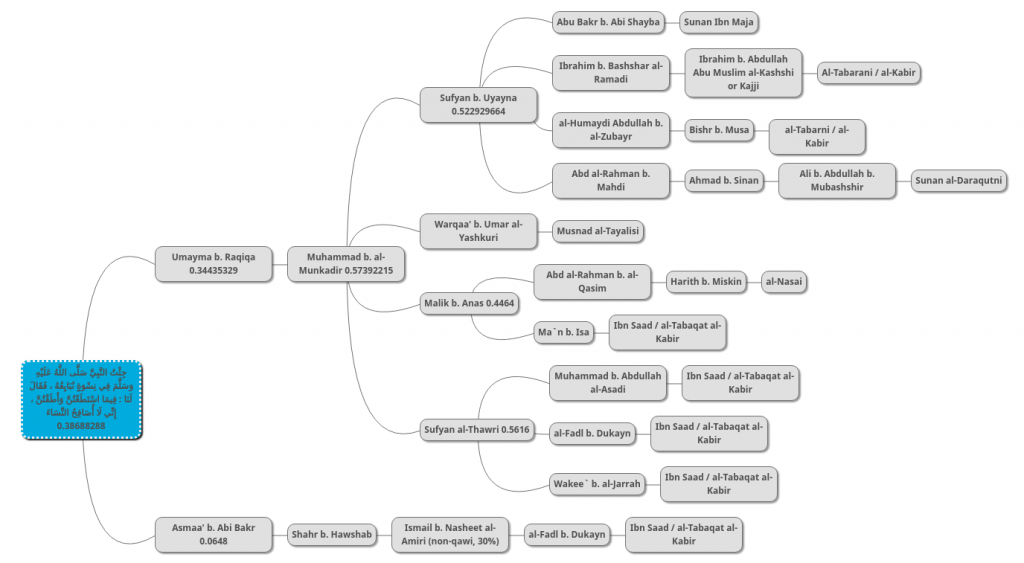
This hadith receives an authenticity score of 38.69% according to our probabilistic hadith verification method. This score is rather high, since sahih hadiths start at 30%, meaning that this hadith is very high-quality.
The next hadith on touching non-mahrams is the following:
Aisha the wife of the Prophet, said, "Allah's Messenger (ﷺ) used to examine the believing women who migrated to him in accordance with this Verse: 'O Prophet! When believing women come to you to take the oath of allegiance to you… Verily! Allah is Oft-Forgiving Most Merciful.' (60.12) `Aisha said, "And if any of the believing women accepted the condition (assigned in the above-mentioned Verse), Allah's Messenger (ﷺ) would say to her. "I have accepted your pledge of allegiance." "He would only say that, for, by Allah, his hand never touched, any lady during that pledge of allegiance. He did not receive their pledge except by saying, "I have accepted your pledge of allegiance for that."
Sahih al-Bukhari Book 65, Hadith 4891; Sahih Muslim 1866 a; other collections
Below is a chain diagram of the hadith:

This hadith receives an authenticity score of 27.57%, making it close to the authentic mark of 30%.
The above appears to be all of the explicit evidence we have on the touching of non-mahrams.
Evidence from lowering the gaze
The Quran commands us to “lower our gaze”. The context of the two verses that command this make it clear that it refers to gazing at the opposite sex idly and/or lustfully.
Tell the believing men to restrain their looks, and to guard their privates. That is purer for them. God is cognizant of what they do.
And tell the believing women to restrain their looks, and to guard their privates, and not display their beauty except what is apparent thereof, and to draw their coverings over their breasts, and not expose their beauty except to their husbands, their fathers, their husbands' fathers, their sons, their husbands' sons, their brothers, their brothers' sons, their sisters' sons, their women, what their right hands possess, their male attendants who have no sexual desires, or children who are not yet aware of the nakedness of women. And they should not strike their feet to draw attention to their hidden beauty. And repent to God, all of you believers, so that you may succeed. (The Quran, verses 24:30-31)
There are also hadiths that mention the same concept, as in the following:
Jarir said I asked the Apostle of Allaah(ﷺ) about an accidental glance (at a woman). He (ﷺ) said “Turn your gaze away.”
Sunan Abi Dawud 2148
Below is the chain diagram for this hadith:
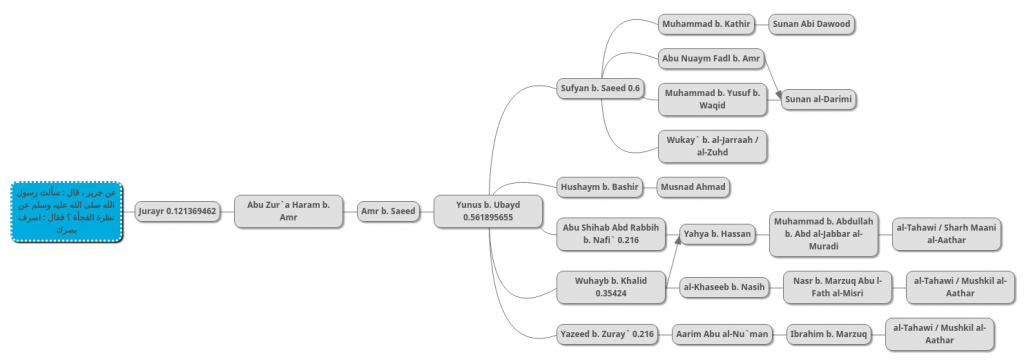
This hadith receives an authenticity score of 12.14%, which is not very high. But it is easier to accept such hadiths as authentic due to their uncontroversial contents.
Naturally, if we are commanded to avoid gazing at the opposite sex idly or lustfully, then the same would apply to touching.
Evidence from the hijab
Another highly relevant area of evidence is that which applies to the rules on parts of the body that have to be covered. Naturally, if we are forbidden from looking at a certain part of a person’s body, we would also be forbidden from touching it. For the evidence on the rulings on which parts of the body should be covered see:
- The purpose of hijab in Islam
- Why the hijab is still obligatory (and why it is not only a vestige of 7th century Arabia)
Conclusion
From the evidence presented above, it is clear that touching the opposite sex idly or lustfully is not permitted in Islam. The Prophet PBUH avoided shaking women’s hands despite this being a harmless form of greeting, which shows us that the highest Islamic ideal is to always work to minimize contact with the opposite sex. However, the evidence does not prohibit necessary touching, as in a doctor touching a person of the opposite sex during a medical procedure.
The exception on shaking hands
Scholars such as Yusuf al-Qaradawi permit shaking the hands of the opposite sex when meeting non-Muslims in order to prevent humiliating them by refusing the handshake, since in such cases avoiding humiliating the person takes priority over the no-touching rule. Shaykh Yusuf al-Qaradawi mentions that while the Prophet PBUH never shook the hands of women, Umar [ra] did that, and Abu Bakr [ra] shook an old woman’s hands.
References:

